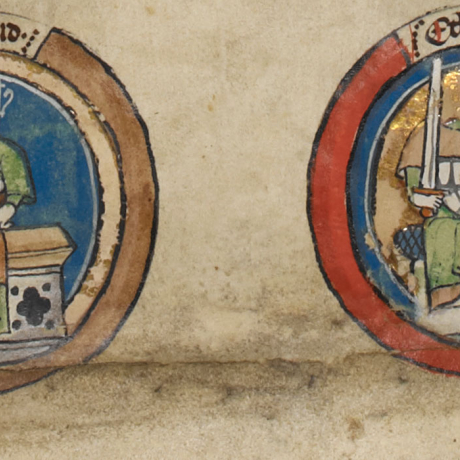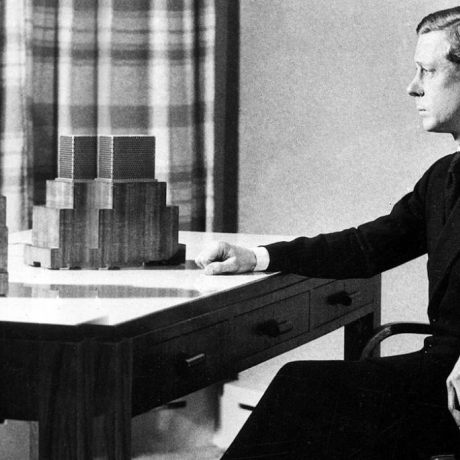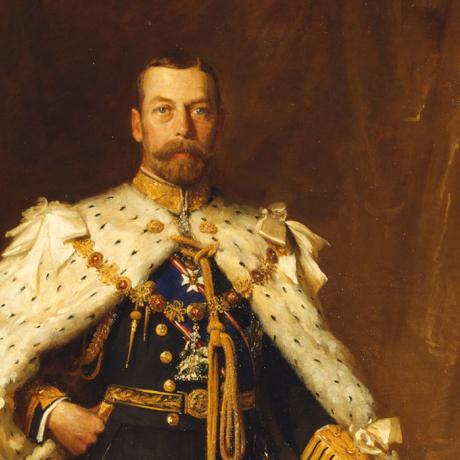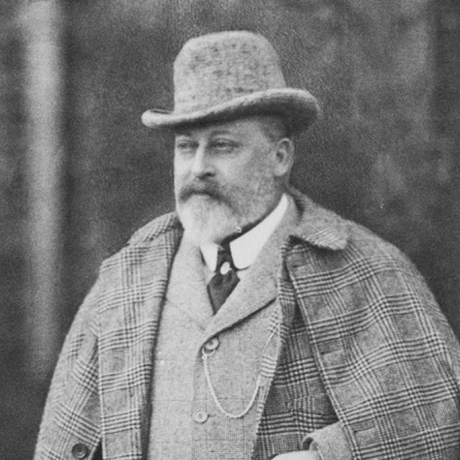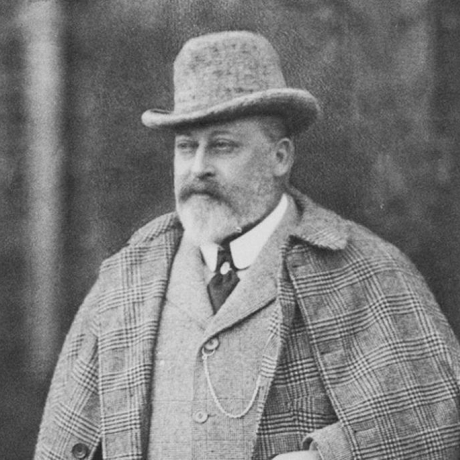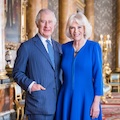Henry VIII was born at Greenwich on 28 June 1491, the second son of Henry VII and Elizabeth of York. He became heir to the throne on the death of his elder brother, Prince Arthur, in 1502 and succeeded in 1509.
In his youth he was athletic and highly intelligent. A contemporary observer described him thus: 'he speaks good French, Latin and Spanish; is very religious; heard three masses daily when he hunted ... He is extremely fond of hunting, and never takes that diversion without tiring eight or ten horses ... He is also fond of tennis.'
Henry's scholarly interests included writing both books and music, and he was a lavish patron of the arts.
He was an accomplished player of many instruments and a composer. Greensleeves, the popular melody frequently attributed to him is, however, almost certainly not one of his compositions.
As the author of a best-selling book (it went through some 20 editions in England and Europe) attacking Martin Luther and supporting the Roman Catholic church, in 1521 Henry was given the title 'Defender of the Faith' by the Pope.
From his father, Henry VIII inherited a stable realm with the monarch's finances in healthy surplus - on his accession, Parliament had not been summoned for supplies for five years. Henry's varied interests and lack of application to government business and administration increased the influence of Thomas Wolsey, an Ipswich butcher's son, who became Lord Chancellor in 1515.
Wolsey became one of the most powerful ministers in British history (symbolised by his building of Hampton Court Palace - on a greater scale than anything the king possessed). Wolsey exercised his powers vigorously in his own court of Chancery and in the increased use of the Council's judicial authority in the court of the Star Chamber.
Wolsey was also appointed Cardinal in 1515 and given papal legate powers which enabled him to by-pass the Archbishop of Canterbury and 'govern' the Church in England.
Henry's interest in foreign policy was focused on Western Europe, which was a shifting pattern of alliances centred round the kings of Spain and France, and the Holy Roman Emperor. (Henry was related by marriage to all three - his wife Katherine was Ferdinand of Aragon's daughter, his sister Mary married Louis IX of France in 1514, and the Holy Roman Emperor Charles V was Katherine's nephew.)
An example of these shifts was Henry's unsuccessful Anglo-Spanish campaigns against France, ending in peace with France in 1520, when he spent huge sums on displays and tournaments at the Field of the Cloth of Gold.
Henry also invested in the navy, and increased its size from 5 to 53 ships (including the Mary Rose, the remains of which lie in the Portsmouth Naval Museum).
The second half of Henry's reign was dominated by two issues very important for the later history of England and the monarchy: the succession and the Protestant Reformation, which led to the formation of the Church of England.
Henry had married his brother's widow, Catherine of Aragon, in 1509. Catherine had produced only one surviving child - a girl, Princess Mary, born in 1516. By the end of the 1520s, Henry's wife was in her forties and he was desperate for a son.
The Tudor dynasty had been established by conquest in 1485 and Henry was only its second monarch. England had not so far had a ruling queen, and the dynasty was not secure enough to run the risk of handing the Crown on to a woman, risking disputed succession or domination of a foreign power through marriage.
Henry had anyway fallen in love with Anne Boleyn, the sister of one of his many mistresses, and tried to persuade the Pope to grant him an annulment of his marriage on the grounds that it had never been legal.
Royal divorces had happened before: Louis IX had been granted a divorce in 1499, and in 1528 James IV's widow Margaret (Henry's sister) had also been granted one. However, a previous Pope had specifically granted Henry a licence to marry his brother's widow in 1509.
In May 1529, Wolsey failed to gain the Pope's agreement to resolve Henry's case in England. All the efforts of Henry and his advisers came to nothing; Wolsey was dismissed and arrested, but died before he could be brought to trial.
Since the attempts to obtain the divorce through pressure on the papacy had failed, Wolsey's eventual successor Thomas Cromwell (Henry's chief adviser from 1532 onwards) turned to Parliament, using its powers and anti-clerical attitude (encouraged by Wolsey's excesses) to decide the issue.
The result was a series of Acts cutting back papal power and influence in England and bringing about the English Reformation.
In 1532, an Act against Annates - although suspended during 'the king's pleasure' - was a clear warning to the Pope that ecclesiastical revenues were under threat.
In 1532, Cranmer was promoted to Archbishop of Canterbury and, following the Pope's confirmation of his appointment, in May 1533 Cranmer declared Henry's marriage invalid; Anne Boleyn was crowned queen a week later.
The Pope responded with excommunication, and Parliamentary legislation enacting Henry's decision to break with the Roman Catholic Church soon followed. An Act in restraint of appeals forbade appeals to Rome, stating that England was an empire, governed by one supreme head and king who possessed 'whole and entire' authority within the realm, and that no judgements or excommunications from Rome were valid.
An Act of Submission of the Clergy and an Act of Succession followed, together with an Act of Supremacy (1534) which recognised that the king was 'the only supreme head of the Church of England called Anglicana Ecclesia'.
The breach between the king and the Pope forced clergy, office-holders and others to choose their allegiance - the most famous being Sir Thomas More, who was executed for treason in 1535.
The other effect of the English Protestant Reformation was the Dissolution of Monasteries, under which monastic lands and possessions were broken up and sold off. From 1518, Wolsey had closed down some of the small monastic communities to pay for his new foundations (he had colleges built at Oxford and Ipswich).
In 1535-6, another 200 smaller monasteries were dissolved by statute, followed by the remaining greater houses in 1538-40; as a result, Crown revenues doubled for a few years.
Henry's second marriage had raised hopes for a male heir. Anne Boleyn, however, produced another daughter, Princess Elizabeth, and failed to produce a male child. Henry got rid of Anne on charges of treason (engineered by Thomas Cromwell and presided over by her uncle, the Duke of Norfolk) which were almost certainly false, and she was executed in 1536. In 1537 her replacement, Henry's third wife Jane Seymour, finally bore him a son, who was later to become Edward VI. Jane died in childbed, 12 days after the birth in 1537.
Although Cromwell had proved an effective minister in bringing about the royal divorce and the English Reformation, his position was insecure. The Pilgrimage of Grace, an insurrection in 1536, called for Cromwell's dismissal (the rebels were put down) but it was Henry's fourth, abortive and short-lived marriage to Anne of Cleves that led to Cromwell's downfall. Despite being made Earl of Essex in 1540, three months later he was arrested and executed.
Henry made two more marriages, to Katherine Howard (executed on grounds of adultery in 1542) and Catherine Parr (who survived Henry to die in 1548).
None produced any children. Henry made sure that his sole male heir, Edward, was educated by people who believed in Protestantism rather than Catholicism because he wanted the anti-papal nature of his reformation and his dynasty to become more firmly established.
After Cromwell's execution, no leading minister emerged in the last seven years of Henry's reign. Overweight, irascible and in failing health, Henry turned his attention to France once more.
Despite assembling an army of 40,000 men, only the town of Boulogne was captured and the French campaign failed. Although more than half the monastic properties had been sold off, forced loans and currency depreciation also had to be used to pay for the war, which contributed to increased inflation. Henry died in London on 28 January 1547 and his son Edward became King.
To some, Henry VIII was a strong and ruthless ruler, forcing through changes to the Church-State relationship which excluded the papacy and brought the clergy under control, thus strengthening the Crown's position and acquiring the monasteries' wealth.
However, Henry's reformation had produced dangerous Protestant-Roman Catholic differences in the kingdom. The monasteries' wealth had been spent on wars and had also built up the economic strength of the aristocracy and other families in the counties, which in turn was to encourage ambitious Tudor court factions.
Significantly, Parliament's involvement in making religious and dynastic changes had been firmly established. For all his concern over establishing his dynasty and the resulting religious upheaval, Henry's six marriages had produced one sickly son and an insecure succession with two princesses (Mary and Elizabeth) each of whom, at some stage, had been declared illegitimate - none of whom were to have children.





